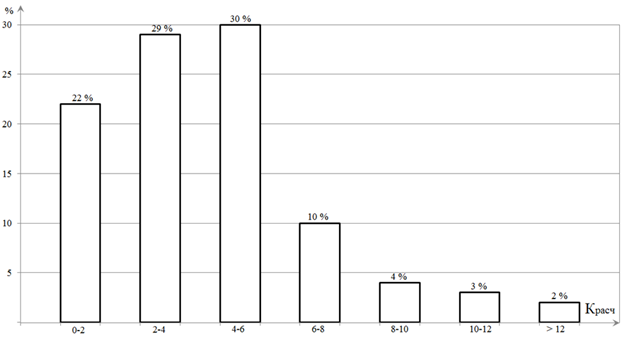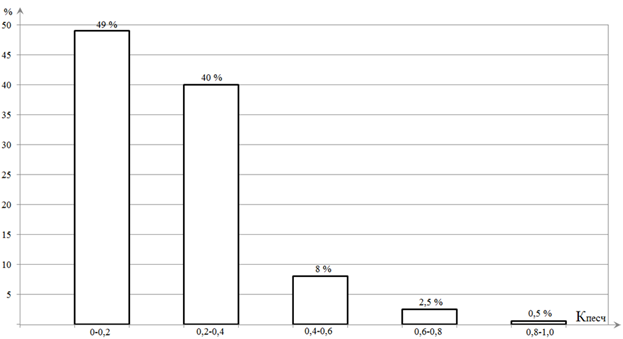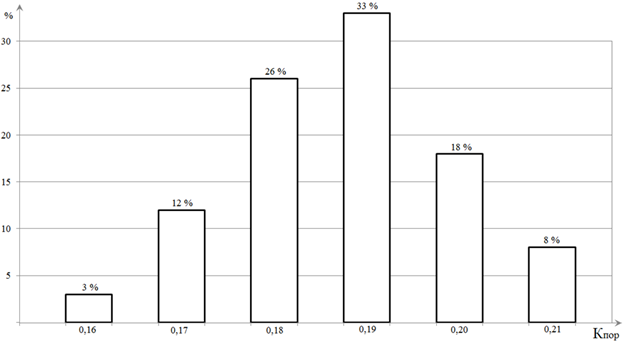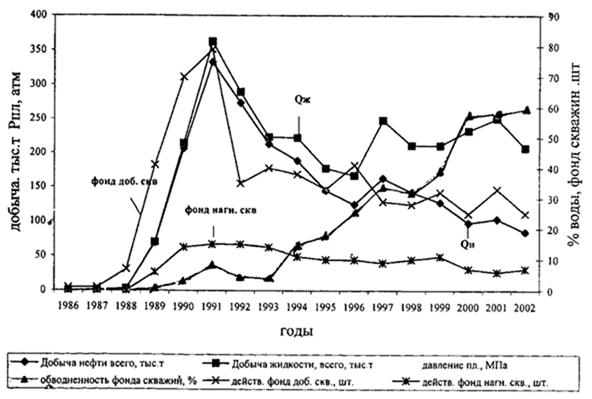СТАТИСТИЧЕСКИЕ МЕТОДЫ ИССЛЕДОВАНИЯ ВОЗМОЖНОСТИ ПОВЫШЕНИЯ ТЕХНОЛОГИЧЕСКОЙ ЭФФЕКТИВНОСТИ МНОГОСТАДИЙНОГО ГИДРОРАЗРЫВА ПЛАСТОВ ПРИ РАЗРАБОТКЕ ГОРИЗОНТА АС-12-3 ПРИОБСКОГО МЕСТОРОЖДЕНИЯ
Салаватова Ю.Ш.1, Ибрагимов Р.М.2, Габдрахманова К.Ф.3
1Студент, 1студент, 2кандидат педагогических наук,
Уфимский государственный нефтяной технический университет
СТАТИСТИЧЕСКИЕ МЕТОДЫ ИССЛЕДОВАНИЯ ВОЗМОЖНОСТИ ПОВЫШЕНИЯ ТЕХНОЛОГИЧЕСКОЙ ЭФФЕКТИВНОСТИ МНОГОСТАДИЙНОГО ГИДРОРАЗРЫВА ПЛАСТОВ ПРИ РАЗРАБОТКЕ ГОРИЗОНТА АС-12-3 ПРИОБСКОГО МЕСТОРОЖДЕНИЯ
Аннотация
В работе рассматриваются статистические методы анализа геолого-физической характеристики фильтрационно-емкостных свойств горизонта БВ8-1, которые способствуют формированию в нем трудноизвлекаемых запасов. На основе проведенного анализа дается обоснование выбора метода интенсификации добычи ТрИЗ на основе применения технологии одностадийного ГРП. На основе математических методов обработки статистических данных его промысловой эффективности установлены количественные критерии выбора параметров трещины по её длине, высоте и количеству закачиваемого в неё проппанта. Анализированы промысловые эффективности, определены приросты ежегодной накопленной добычи не менее чем на 10 – 15 %. Согласно исследованиям, по истечении некоторого времени (4 лет) промысловая эффективность одностадийного ГРП начала также снижаться, что потребовало поиска путей его совершенствования на основе внедрения его многостадийной модификации. Анализ результатов его промыслового опробования позволил получить количественные критерии оптимизации многостадийного ГРП на основе обоснованного выбора как длины и объема трещин, так и их количества, что позволило обеспечить достижение планового КИН при разработке горизонта АС-12-3 в установленные и согласованные с ГКЗ РФ сроки.
Ключевые слова: статистические методы, трудноизвлекаемые запасы, промысловая эффективность, одностадийного ГРП, количественные критерии, многостадийное ГРП.
Salavatova Yu.Sh.1, Ibragimov R.M.2, Gabdrahmanova K.F.3
1Student, 2student, 3 PhD in Pedagogy,
Ufa State Oil Technical University
STATISTICAL METHODS POSSIBILITY OF INCREASING THE TECHNOLOGICAL EFFICIENCY OF THE MULTI-STAGE FRACTURING IN THE DEVELOPMENT OF HORIZON AC-12-3 “PRIOBSKOE” FIELD
Abstract
The paper deals with statistical methods for analysis of geological and physical characteristics of the reservoir properties of the horizon AC-12-3, which help to shape it hard to recover reserves. On the basis of the analysis given rationale for the choice of the method TRIZ stimulation through the use of a single-stage hydraulic fracturing technology. On the basis of mathematical methods of statistical data processing of its commercial efficiency to quantitative selection criteria fracture parameters of its length, height and amount of proppant pumped into it. Analyze the efficiency of fishing, on the growth of the annual cumulative production by at least 10 - 15%. According to studies, after some time craft efficiency single-stage hydraulic fracturing has also begun to decline, which required finding ways to improve it by introducing its multi-stage modification. Analysis of the results of its commercial testing yielded quantitative criteria optimization of multi-stage hydraulic fracturing based on informed choice as the length and scope of the cracks and their number that would achieve the planned recovery factor in the development of AC-12-3 horizon within the SRC and agreed to the terms of the Russian Federation.
Keywords: statistical methods, hard-to-recover reserves, field efficiency, single-stage hydraulic fracturing, quantitative criteria for multistage fracturing.
Unique “Priobskoe” part of a large-“Khulymskoye Priobskaya” zone of oil and gas, which is a broad band stretches from North to South in the central part of the West Siberian Plain.
According to geological studies -commercial, oil saturation thickness of the deposit has stratified character and represents the main productive horizon formation AC-12-3 “Cherkashinskoye” suite, whose power is increased (up to 16 - 18 m) to the crest of the field and decreases (up to 4 - 5 m ) in its zone of the wing.
Fig. 1 shows the histograms of the effective oil-saturated reservoir capacity AC-12-3, which show that it is not more than 50% of the actual capacity of the reservoir and its prevailing value of from 3 to 7 meters is 60%, and the remaining capacity from 1 to 3 and 8 m to 10 m have less than 40%.
Fig. 1 – Histogram of distribution of effective oil-saturated reservoir AS12-3 power [2]
Besides the formation of AC-12-3 it is characterized by relatively high ruggedness, which in the case of the presence of from 2 to 6 seams up to 80% or more (see. Fig. 2).
Fig. 2 – Histogram distribution of dissection AS12-3 producing formation [2]
Productive layer has a sufficiently low-to-gross ratio, the share of which is about 0.4 to 90% (see. Fig. 3), due to the relatively high coefficient of clay (CHF = 5 8%), despite the rather high average intergranular porosity of the reservoir (see. Fig. 4) equal to 19%, is the cause of its low permittivity (45 - 90 mpc) with an average oil content of 62 to 76%.
Ultimately, given reservoir properties of the formation AC-12-3 allows it to carry therein oil to the category of hardness, leading to their irregular development area of occurrence.
Fig. 3 – Histogram-gross distribution of productive formation AS12-3 [2]
Fig. 4 – Histogram distribution of the porosity producing formation AS12-3 [2].
In accordance with the project specification mode is selected with the SRC calculation produce a single crack in the productive strata height (STR) to 0.8 - 0.9 NPL long Length of tube to 70 - 80 meters and disclosure (B) 3 - 5 mm.
Evaluation of the effectiveness of fishing EMG showed that it was about 50%. Analysis of the results failed EMG showed that they are usually accompanied by low growth in debit and watering, compared to the original, although the selected wells were located in the zone of relatively high residual reserves [5, 6].
The study of the structural features of the field and their comparison with the direction of the faults underlying the foundation found that in the wing areas of sedimentary strata formed sections of stress.
Fig. 5 – Dynamics of the formation operation AS12-3 “Priobskoe” field [1]
The state of rock, accompanied by the formation of a natural fracture having a predominantly axial (along Valo-shaped structure field) direction.
Comparison of the data from the failed hydraulic fracturing of wells located in areas of concentration of remaining reserves and the direction in which the natural fractures found that they are due to hit the second wing cracks in the area of depleted stocks with high water content, which may explain their low efficiency [7].
At this stage, experimental and industrial testing of the multi-stage fracturing technology selection of wells was carried out on the following criteria [4]:
- oil saturated reservoir thickness not less than 3 m;
- potential production rate (maximum flow rate in the history of exploitation) is not less than 10 tons / day;
- initial oil saturation Кн > 0,4 + 0,15·(1 –
 );
); - power overlying and underlying screens at least 3 m.
- the ratio of current to the initial reservoir pressure of at least 0.9.
- the condition of the cement stone in the range of ± 20 m had good perforation;
- well should not have casing flows;
- water cut of not more than 50%;
- the angle deviation of the wellbore from the vertical interval of the formation is not more than 10 °;
- watering of the surrounding wells no more than 70%.
In order to study the efficiency of the process, technology of hydraulic fracturing was carried out on, the basis of proven techniques previously studied on the effects on her cracked parameters: length, height, width, and the number of proppant. [8]
As a result, it was found that with increasing crack length increases the initial oil production rate and reduced water cut, which follows from the graphs shown in Fig. 6, 7.
It was found that with increasing height of the crack on the effective capacity of the reservoir decreases oil production rate, and the water content; but on the contrary, it increases, as can be seen from the graphs shown in Fig. 8, 9. Such behavior is clearly associated with a decrease in the effective oil-saturated reservoir capacity as the development of reserves in the course of continuous operation.
By using the selection criteria derived from optimum parameters of a multi-stage hydraulic fracturing technology, we managed not only to stop the incipient decline in current production accumulated during the operation of the formation of AC-12-3, but also provide it to an increase in 2006 (see. Fig.11). However, after 2006, as can be seen from the graphs, there has been a decline in the next accumulated current production due to the inevitable decline in the efficiency of a single-stage hydraulic fracturing technology [9].
Alternatively, single-stage hydraulic fracturing technology has been developed a multistage fracturing when the formation is being drilled and the horizontal shaft therein using special equipment technology to create multiple fractures in a certain spaced interval from each other [10].
From the dependency, it implies that the range of estimated production rates and selling are almost the same, indicating that quite perfect method of forecasting the effect of fishing on multi-stage hydraulic fracturing. [6]
References
- Bolsman T. A. Phase behavior of Alkyl Xylene sulfonate (oil) brine Systems.// 2-nd European Symposium EOR.- Paris.-1982.-P.215-227.
- Fracturing / Educational-methodical unit № 1. Tomsk, 2002. - 35 p.
- Gabdrahmanov NH, Galiullin MF Galiullin TS Malets ON, MY Aschepkov The methods of enhanced oil recovery - the basis of rational development of oil field. // STJ Oilfield delo.A-2002.- № 5.-S.8-10.
- Galiev RG Increased production of hard-to-hydrocarbon reserves. // Moscow- Cup - AG-1997-S.22-34.
- Gutorov YA, Gabdrakhmanova KF, Larin PA Probability theory and mathematical statistics, examples and problems of development of oil fields. (Tutorial allowed UMO PAE on classical university and technical education), Ufa :, UGNTU, 2013, 134 p.
- Gutorov YA, Shakurov AF The basic technology of hydraulic fracturing in oil and gas wells // Ufa, UGTNU, 2009. - 199 p.
- Joe M. Mack. Larger flow rates after fracturing effectively in Russia / Methodology and procedure of calculation of the simulation characteristics of the inflow wells after fracturing / University of Houston, 2002 - 28.
- JuntgenН., Teichmuller М., Zirndorf D. Eigenschaften Tektonischer Steinkohlen. // Brennstoffchemie.-1969.-Bd.50.-N 2.-P.54-62.
- Maneel Braman. Hydraulic fracturing and its quality control / courses for the company "Sibneft". 2004 - 600 .
- Michael Economides Zhd. Advances in the development of deposits of Houston University, 2002. - 476 p.
- Nur A. Dilatancy, pore fluids, and premonitory variations of Vp/Vs.// Bull. Seismol.Sos.Amer.- 1972, № 5.-P.1217-1222.
- Proskurin VA Improving technology multi-stage hydraulic fracturing in horizontal wells / thesis for the account. Art. Ph.D. Spec. 25.00.17, Ufa, IPTER 2013.





